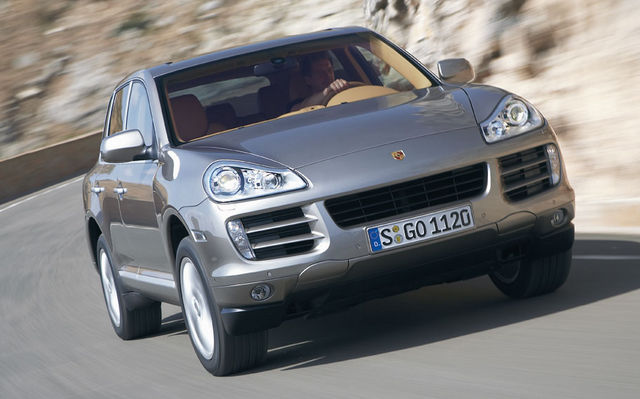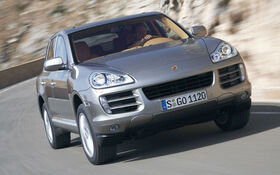Porsche Cayenne 2008 , more spicy !
We all remember the stir the Cayenne created when it was introduced in 2003. People wondered why Porsche, known for its sports cars, was getting into SUVs. But for Porsche, just like any other company, money speaks louder than ideals. And disappointed purists should know that thanks to the Cayenne, Porsche has doubled its sales, attracted new clients and seen increased investments from dealers, all of which makes for greater revenue that can be spent on developing other product lines. Four years later, you’ve got to admit the SUV was well worth the effort.
When “sport utility” means “sport utility”
A perfect blend of these two words, the 2008 Porsche Cayenne gives new meaning to this term. Now, you won’t find a 2007 Cayenne, it simply doesn’t exist. And though there are still a few 2006 models available, the 2008 Cayenne is slated to take the stage at the beginning of March. This year, all trim levels are coming out with new engines and more power, resulting from the addition of a direct injection system. Manufacturers are using this technology more and more often because its benefits are two-fold: increased power and better fuel economy. Direct injection systems minimize fuel loss because gasoline is injected right into the cylinder, where air is mixed in.
Three models: one for each budget
The Cayenne V6 ($58,900) targets people with less money to spend who nonetheless want to share in the brand’s prestige, even if this vehicle doesn’t offer the same performance as the other models. This model has a 3.6-litre 6-cylinder engine with 290 hp, which is 40 more than last year’s model. The Cayenne S has also had a power boost—its 4.8-litre V8 engine has gone from 340 to 384 hp. And for the first time, this V8 engine has a VarioCam variable valve timing system. The top of the line is the Cayenne Turbo ($124,300), a 500-hp bomb that can go from 0-100 in less than 5 seconds and can reach a maximum speed of 275 km/hr. At the heart of this model is a 4.8-litre twin-turbochargedV8 engine. Although Porsche introduced the Turbo S in 2006, it will be a while before we see more of those. As for the hybrid Cayenne the company plans to introduce before 2010, performance will remain a top priority. As always, there is no shortage of interesting options, but all come with a big price tag attached!
A little more exotic
When the Cayenne was first released, there were also complaints about its style. Despite the fact it carried the Porsche name, the Cayenne was not very exotic. The 2008 version, however, has been touched up, improving the overall appearance. Improvements include less imposing headlamps at the front, making the vehicle look more refined and less like a truck, and bigger air dams taken from the old Turbo model. All trim levels got new rims, and 21-inch wheels are available as an option. At the back, LED tail lights provide more elegance.
When it comes to Porsches, not much is said about equipment, luxury or comfort. While the technologies on board are mainly to enhance performance, the manufacturer has got with the times and added a navigation system as well as a sound system that plays MP3s and satellite radio.
Spiced-up performance
Though the Cayenne has decent off-road performance, it was made to go where 99% of its buyers will take it: the open road. Its performance on pavement won’t let you down. Few cars can boast the same level of performance as this SUV, which delivers despite the fact it weighs more than 5,000 lbs. The various Cayenne versions aren’t just equipped with efficient, high-performance engines, but they also come with a braking system that can stop as quickly as a traditional car. To achieve this, Porsche added new brakes with aluminium monoblock callipers. Result: enhanced rigidity, less weight and a better braking surface.
Another element worth mentioning this year is the addition of a PDCC system (Porsche Dynamic Chassis Control). It uses a series of sensors as well as active anti-roll bars with variable tension thanks to a hydraulic pump which has been added at the centre. In practical terms, this means that the system maximises the vehicle’s performance within a the thousandth of a second under diverse conditions. Successive trials of vehicles both with and without this system were fairly convincing: we noticed right away that weight shifted significantly less during cornering manoeuvres and general performance was improved. What’s the catch? This is another option offered for a big price.
On the road, the V6 model just doesn’t have that same intoxicating power as the two other versions and seems a little bare when it comes to equipment. In its defence, it has much better fuel economy, though that isn’t usually a big concern for Porsche buyers. The S and Turbo love the road and perform more like sport sedans than SUVs. For them, windy roads are a fun way of proving their ability.
The 2008 Cayenne is one step further along the avolutionary chain. Its new exterior should quell some concerns and the addition of new technology makes this SUV more efficient. And though the vehicle doesn’t offer anything to really hush its critics, it has at least come up a notch from its initial premise. That aside, the Cayenne is the only Porsche that can fit your whole family as well as all your weekend gear. At least you won’t have to leave your Porsche at home when taking the family out.
Summary:
Test vehicle: 2008 Porsche Cayenne
Price range: $58,900 to $124,300
Test model price: $78,500
Options: None
Shipping costs: $1,085
Basic warranty: 4 years/80,000 km
Competition: Audi Q7, BMW X5, Cadillac SRX, Infiniti FX, Jeep Grand Cherokee, Volkswagen Touareg
Strengths:
• Undeniable performance
• Improved style
• Power
• Brand prestige
Weaknesses:
• Expensive options
• Steering wheel grip less sporty
• High fuel consumption












